Pannexin2 oligomers localize in the membranes of endosomal vesicles in mammalian cells while Pannexin1 channels traffic to the plasma membrane
- PMID: 25698922
- PMCID: PMC4313697
- DOI: 10.3389/fncel.2014.00468
Pannexin2 oligomers localize in the membranes of endosomal vesicles in mammalian cells while Pannexin1 channels traffic to the plasma membrane
Abstract
Pannexin2 (Panx2) is the largest of three members of the pannexin proteins. Pannexins are topologically related to connexins and innexins, but serve different functional roles than forming gap junctions. We previously showed that pannexins form oligomeric channels but unlike connexins and innexins, they form only single membrane channels. High levels of Panx2 mRNA and protein in the Central Nervous System (CNS) have been documented. Whereas Pannexin1 (Panx1) is fairly ubiquitous and Pannexin3 (Panx3) is found in skin and connective tissue, both are fully glycosylated, traffic to the plasma membrane and have functions correlated with extracellular ATP release. Here, we describe trafficking and subcellular localizations of exogenous Panx2 and Panx1 protein expression in MDCK, HeLa, and HEK 293T cells as well as endogenous Panx1 and Panx2 patterns in the CNS. Panx2 was found in intracellular localizations, was partially N-glycosylated, and localizations were non-overlapping with Panx1. Confocal images of hippocampal sections immunolabeled for the astrocytic protein GFAP, Panx1 and Panx2 demonstrated that the two isoforms, Panx1 and Panx2, localized at different subcellular compartments in both astrocytes and neurons. Using recombinant fusions of Panx2 with appended genetic tags developed for correlated light and electron microscopy and then expressed in different cell lines, we determined that Panx2 is localized in the membrane of intracellular vesicles and not in the endoplasmic reticulum as initially indicated by calnexin colocalization experiments. Dual immunofluorescence imaging with protein markers for specific vesicle compartments showed that Panx2 vesicles are early endosomal in origin. In electron tomographic volumes, cross-sections of these vesicles displayed fine structural details and close proximity to actin filaments. Thus, pannexins expressed at different subcellular compartments likely exert distinct functional roles, particularly in the nervous system.
Keywords: ATP signaling; connexin; correlated light and electron microscopy; electron tomography; intercellular communication; miniSOG; pannexin channels; tetracysteine tag.
Figures
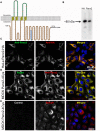
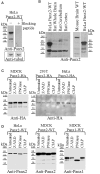


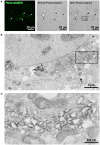
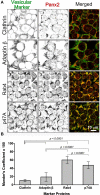
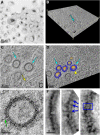
Similar articles
-
Pannexin1 and Pannexin2 channels show quaternary similarities to connexons and different oligomerization numbers from each other.J Biol Chem. 2010 Aug 6;285(32):24420-31. doi: 10.1074/jbc.M110.115444. Epub 2010 Jun 1. J Biol Chem. 2010. PMID: 20516070 Free PMC article.
-
N-Glycosylation Regulates Pannexin 2 Localization but Is Not Required for Interacting with Pannexin 1.Int J Mol Sci. 2018 Jun 22;19(7):1837. doi: 10.3390/ijms19071837. Int J Mol Sci. 2018. PMID: 29932112 Free PMC article.
-
Glycosylation regulates pannexin intermixing and cellular localization.Mol Biol Cell. 2009 Oct;20(20):4313-23. doi: 10.1091/mbc.e09-01-0067. Epub 2009 Aug 19. Mol Biol Cell. 2009. PMID: 19692571 Free PMC article.
-
The biochemistry and function of pannexin channels.Biochim Biophys Acta. 2013 Jan;1828(1):15-22. doi: 10.1016/j.bbamem.2012.01.017. Epub 2012 Jan 28. Biochim Biophys Acta. 2013. PMID: 22305965 Review.
-
Mechanisms of Pannexin 1 (PANX1) Channel Mechanosensitivity and Its Pathological Roles.Int J Mol Sci. 2022 Jan 28;23(3):1523. doi: 10.3390/ijms23031523. Int J Mol Sci. 2022. PMID: 35163442 Free PMC article. Review.
Cited by
-
Permanent Photodynamic Activation of the Cholecystokinin 2 Receptor.Biomolecules. 2020 Feb 4;10(2):236. doi: 10.3390/biom10020236. Biomolecules. 2020. PMID: 32033232 Free PMC article.
-
Exciting and not so exciting roles of pannexins.Neurosci Lett. 2019 Mar 16;695:25-31. doi: 10.1016/j.neulet.2017.03.010. Epub 2017 Mar 8. Neurosci Lett. 2019. PMID: 28284836 Free PMC article. Review.
-
Pannexin 1 as a driver of inflammation and ischemia-reperfusion injury.Purinergic Signal. 2021 Dec;17(4):521-531. doi: 10.1007/s11302-021-09804-8. Epub 2021 Jul 12. Purinergic Signal. 2021. PMID: 34251590 Free PMC article. Review.
-
Editorial: Single membrane channels formed by connexins or pannexins: focus on the nervous system.Front Cell Neurosci. 2015 Oct 15;9:402. doi: 10.3389/fncel.2015.00402. eCollection 2015. Front Cell Neurosci. 2015. PMID: 26528132 Free PMC article. No abstract available.
-
Pannexins in the musculoskeletal system: new targets for development and disease progression.Bone Res. 2024 May 6;12(1):26. doi: 10.1038/s41413-024-00334-8. Bone Res. 2024. PMID: 38705887 Free PMC article. Review.
References
-
- Boassa D., Berlanga M. L., Yang M. A., Terada M., Hu J., Bushong E. A., et al. . (2013). Mapping the subcellular distribution of alpha-synuclein in neurons using genetically encoded probes for correlated light and electron microscopy: implications for Parkinson's disease pathogenesis. J. Neurosci. 33, 2605–2615. 10.1523/JNEUROSCI.2898-12.2013 - DOI - PMC - PubMed
Grants and funding
LinkOut - more resources
Full Text Sources
Other Literature Sources
Miscellaneous

